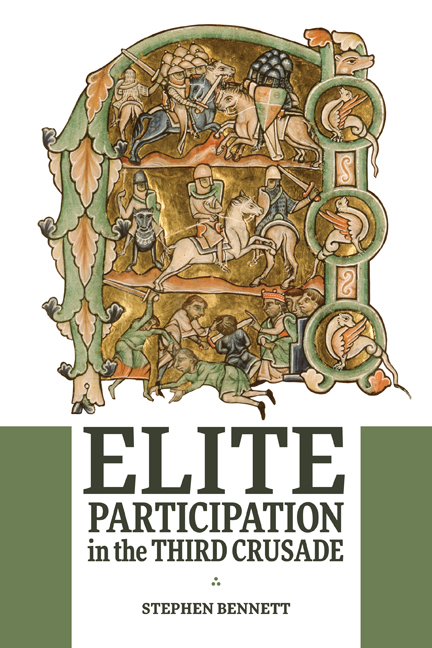Book contents
- Frontmatter
- Contents
- List of Illustrations
- Preface and Acknowledgements
- List of Abbreviations
- Notes on Sources, Names, and Coinage
- Map
- Introduction
- 1 Faith and Finance: Religious Foundations, Ecclesiastical Leaders, and Fraternity
- 2 Family and Heritage: Lineage, Kinship, and Tradition
- 3 Locality and Fellowship: Territory, Trade, and Tournaments
- 4 The Household of King Richard I at the Time of the Third Crusade
- Conclusion: Personal, Spiritual, and Communal Influences on Participation in the Third Crusade
- Appendices
- Bibliography
- Index
- Warfare in History
1 - Faith and Finance: Religious Foundations, Ecclesiastical Leaders, and Fraternity
Published online by Cambridge University Press: 09 February 2021
- Frontmatter
- Contents
- List of Illustrations
- Preface and Acknowledgements
- List of Abbreviations
- Notes on Sources, Names, and Coinage
- Map
- Introduction
- 1 Faith and Finance: Religious Foundations, Ecclesiastical Leaders, and Fraternity
- 2 Family and Heritage: Lineage, Kinship, and Tradition
- 3 Locality and Fellowship: Territory, Trade, and Tournaments
- 4 The Household of King Richard I at the Time of the Third Crusade
- Conclusion: Personal, Spiritual, and Communal Influences on Participation in the Third Crusade
- Appendices
- Bibliography
- Index
- Warfare in History
Summary
Therefore indeed the soldiers of Christ sign themselves with the sign of the cross on the body, sign on the heart, sign externally by the image, sign internally by penance; they bear the cross of Christ not with Simon [of Cyrene] as an obligation, but with Christ in patience; with the right-hand robber in penance, not with the left-hand [robber] in violence.
Alan of Lille, 1189This chapter demonstrates that, along with the recovery of Jerusalem, the concept of following in Christ's footsteps (imitatio Christi) was a significant influence on motivation to take the Cross and join the Third Crusade. Whilst it is a topic that has not gone unnoticed by historians, the question of crusader spirituality in relation to participants in this expedition has either received little attention or has been subordinated to emphasis on the roles of the Great Men.
Jean Leclercq introduced the idea that the crusades should be considered as part of the same process that brought about twelfth-century religious reform, including the foundation of the Military Orders and reformed orders, such as the Cistercians and Premonstratensians. The intersection between monastic reform and crusading has been evidenced in a number of studies. It is a theme that is reflected in Jonathan Riley-Smith's argument that the First Crusade was considered by some contemporaries to be ‘a military monastery on the move’. Similarly, in his study of the religious practices of members of the military elite, Marcus Bull identified the close relationship between transactions with religious institutions and those beliefs that generated enthusiasm for a crusade.
Giles Constable also placed the devotions of crusaders firmly within the framework of overall medieval religious practice. Rather than focusing purely on the professed religious – monks and canons – he suggested that historians should place religious experience at the centre. He argued that a pilgrimage or a crusade ‘might fill as profound a need in some people as a lifetime of reciting psalms or enclosed in a cell did for others’.In his study of crusading spirituality, William Purkis established the crucial importance of the ideal of imitatio Christi to crusading spirituality, and he bridged the gap identified by Constable between crusading, pilgrimage, and monasticism.
- Type
- Chapter
- Information
- Elite Participation in the Third Crusade , pp. 29 - 89Publisher: Boydell & BrewerPrint publication year: 2021

